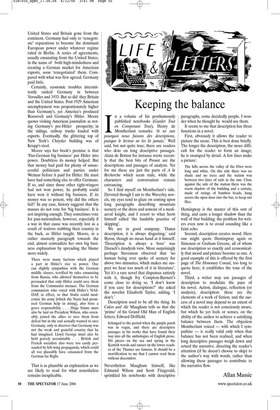Keeping the balance
In a volume of his posthumously published notebooks (Garder Tout en Composant Tout), Henry de Montherlant remarks: ‘Je ne sais pourquoi nous faisons des descriptions, puisque le lecteur ne les lit jamais.’ Well said, but not quite true; there are readers who dote on long descriptive passages. Alain de Botton for instance wrote recently that the best bits of Proust are the descriptions and passages of analysis. Yet for me these are just the parts of A la Recherche which seem stale, while the characters and conversation remain entrancing.
So I find myself on Montherlant’s side. Devoted though I am to the Waverley novels, my eyes tend to glaze on coming upon long paragraphs describing mountain scenery or the dress and armour of a mediaeval knight, and I resort to what Scott himself called ‘the laudable practice of skipping’.
We are in good company. ‘Damn description, it is always disgusting,’ said Byron, though no mean hand at it himself. ‘Description is always a bore’ was Disraeli’s dandyish view. More surprisingly perhaps Stevenson observed that ‘no human being ever spoke of scenery for above two minuutes, which makes me suspect we hear too much of it in literature’. Yet it’s a rare novel that dispenses entirely with it, though Ivy Compton-Burnett’s come close to doing so. ‘I don’t know if you care for descriptions?’ she asked the novelist Elizabeth Taylor, adding, ‘I don’t.’ Description used to be all the thing. In Cakes and Ale Maugham tells us that the ‘prime’ of his Grand Old Man of English letters, Edward Driffield,
belonged to the period when the purple patch was in vogue, and there are descriptive passages in his works that have found their way into all the anthologies of English prose. His pieces on the sea and spring in the Kentish woods and sunset on the lower reaches of the Thames are famous. It should be a mortification to me that I cannot read them without discomfort.
Nevertheless Maugham himself, like Edmund Wilson and Scott Fitzgerald, sprinkled his notebooks with descriptive paragraphs, some decidedly purple. I wonder when he thought he would use them.
It seems to me that description has three functions in a novel.
First, obviously it allows the reader to picture the scene. This is best done briefly. The longer the description, the more difficult for the reader to form an image; he is swamped by detail. A few lines make a picture:
The hills across the valley of the Ebro were long and white. On this side there was no shade and no trees and the station was between two lines of rails in the sun. Close against the side of the station there was the warm shadow of the building and a curtain, made of strings of bamboo beads, hung across the open door into the bar, to keep out flies.
Hemingway is the master of this sort of thing, and casts a longer shadow than the wall of that building; the problem for writers even now is to avoid sounding like a faint echo.
Second, description creates mood. Here one might quote Hemingway again or Simenon or Graham Greene, all of whom use description so exactly and economically that mood and picture become as one. A good example of this is offered by the first page of The Honorary Consul, too long to quote here; it establishes the tone of the novel.
Third, a writer may use passages of description to modulate the pace of his novel. Action, dialogue, reflection (or analysis), description: these are the elements of a work of fiction; and the success of a novel may depend to an extent of which the reader is not consciously aware, but which he yet feels or senses, on the ability of the author to achieve a satisfying balance between them. The objection Montherlant voiced — with which I sympathise — is really valid only when that balance has not been realised, and when long descriptive passages weigh down and retard the narrative, directing the reader’s attention (if he doesn’t choose to skip) to the author’s way with words, rather than allowing these passages to contribute to the narrative flow.
Allan Massie


















































































 Previous page
Previous page